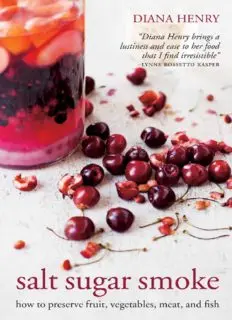
Salt Sugar Smoke: How to Preserve Fruit, Vegetables, Meat and Fish PDF
Preview Salt Sugar Smoke: How to Preserve Fruit, Vegetables, Meat and Fish
salt sugar smoke how to preserve fruit, vegetables, meat and fish DIANA HENRY MITCHELL BEAZLEY contents introduction jam vats of sunshine: a history of marmalade jellies, curds, and fruit pastes sauces, pastes, mustards, and vinegars patience and old wine: how vinegars are made under oil smoked syrups, alcohols, fruits, and spoon sweets a little something french: the art of the apéritif sharbats and mint tea: middle eastern pleasures salted, cured, and potted in coolness, in silence and in shadow: scandinavian salt-cured fish chutneys, relishes, and pickles perfect partners: the surprising possibilities of the cheese board a barrel of cucumbers: preserving in america from russia with love: the joy of the zakuski table ash helicopters and mangoes on the roof: pickling in britain and india Canning preserves for long-term storage index acknowledgements how to use this ebook Select one of the chapters from the main contents list and you will be taken to a list of all the recipes covered in that chapter. Alternatively, jump to the index to browse recipes by ingredient. Look out for linked text (which is in orange) throughout the ebook that you can select to help you navigate between related recipes. introduction Lifelong loves take hold early on. My mum did a lot of baking when we were growing up, and I have a clear memory of sitting on the countertop in our small kitchen as she sliced warm wheaten bread and spread a piece with raspberry jam for me. The jam was made by Aunt Sissy, who wasn’t an aunt at all, but an elderly family friend and a tremendous preserver. That jam was better than any fruit I ever tasted fresh. Aunt Sissy’s jams were soft set and ran off the bread. They were so loved, we only ate them on homemade bread or in a sandwich. At home, we seemed to be surrounded by great jam and chutney makers and we loved getting jars from them. So I always appreciated preserved foods, and I have been preserving this or that—chutney, gravlax, pork rillettes (a kind of pâté)—since I was in my mid- teens. But preserving is the kind of cooking you always feel “experts” do. I felt I needed to have an indenture period, to spend, like Aunt Sissy, every day of the summer with kettles on the go. Several years ago I decided to do this. I wanted to improve skills I already had, to understand why I followed certain rules, to make up my own recipes, to feel confident about salting herrings and duck. Salt Sugar Smoke is the result of a rigorous exploration and a long journey. For three years, I preserved food every day, often well into the night. My laundry room filled up with jars. The refrigerator became home to slabs of bacon and chunks of beef. I discovered I could go my own way. It may be traditional in Great Britain, where I live, to use equal quantities of sugar and fruit to make firm-set, sweet jams. However, they make soft-set jams in France and lower sugar jams in Scandinavia, so I made the kind of jams I preferred: soft-set and not too sweet. I am a home cook. I don’t have masses of special equipment and I don’t do things on a grand scale. A lot of the literature that existed on preserving was off- putting. I didn’t want to turn my shed into a smokery. I could never manage— and would never need—to cure a whole pig. I have done everything in this book in a gentle way and didn’t spend much on new equipment. I bought an additional kettle, some more wooden spoons, a wide funnel for pouring jams through, a lot of measuring cups, a big plastic box (a storage box from IKEA) to use for brining, and a little stove-top smoker. Then I started my journey. I had, as the saying goes, a ball. I discovered that preserving made you feel as if you were more than just a cook. There were days when it reminded me of being on my grandparents’ farm. It felt as if I was presiding over something natural that had its own momentum, but which I had a hand in. Fish and pork changed because of the application of salt, for example, and I oversaw this and took it to the next stage. There was a tremendous thrill in producing food that was more than a meal. Like a child in a craft class, I have always loved making things, and preserving and curing produced that feeling about a hundred times over. And the food was delicious. People have always preserved because they needed to—it was about survival. However, the reason we still bother to do it at home is because the end products taste so good. My daily cooking changed. There were so many different condiments on the go that I did a lot of plain meals using these as embellishments: rice and vegetable dishes with chutneys, roasts with relishes, simple cakes with sumptuous fillings of unusual jams. I have always thought that home cooking— especially the quick kind we do a lot these days—is about accessorizing. We have to think of something good to do with a pork chop or a piece of fish. I want everybody who reads this book to feel they can preserve and do some basic curing. However, to get the best out of it, please read the chapter
